Installation – Best Practices and Optimizations
Veeam Backup & Replication v12 is part of the Veeam Availability Suite, the newest release for Veeam, and allows you to back up all your workloads, including cloud, virtual, physical, and applications. As we have seen from previous versions, it is simple yet flexible to meet your most challenging environment needs. This chapter will discuss how to install and upgrade the software, what components make up Veeam Backup & Replication v12, and some best practices and optimizations. There will be practical examples throughout this chapter of optimizing specific elements that make up the Veeam environment. We will also touch on some websites, such as the Best Practices Guide for Veeam, to give you resources to help you set up Veeam in your environment. As they say about Veeam – “It Just Works.”
In this chapter, we’re going to cover the following main topics:
- Understanding the best practices and optimizations for Veeam installation
- Configuring and optimizing Proxy Servers
- How to set up Repository Servers for success
- Understanding the Scale-Out Backup Repository (SOBR)
- Upgrading Veeam Backup & Replication to v12
Technical requirements
To ensure a successful installation, you will require the following:
- You must have Windows Server 2019/2022 deployed with the necessary disk space to install the application (2012/2008 R2 SP1 is also currently supported). Windows 10 and other modern Windows desktop operating systems are also supported. Please see the following website for the operating system requirements: https://helpcenter.veeam.com/docs/backup/vsphere/system_requirements.html?ver=120#backup-server.
- You must have downloaded the latest ISO file from www.veeam.com, which requires registering on the site and allows you to obtain a trial license. At the time of writing, version
12.0.0.1420is the current release. - Veeam Best Practices website: https://bp.veeam.com/vbr/.
- Veeam documentation website: https://helpcenter.veeam.com/docs/backup/vsphere/overview.html?ver=120.
Understanding the best practices and optimizations for Veeam installation
Installing Veeam Backup & Replication v12 is a straightforward process. Setting up Veeam, if not done right, can lead to components not working correctly and poor performance, among other things. It will protect your data and environment with minimal configuration when set up correctly. This section will go through the installation process and touch on the best practices and optimizations for your environment.
Installing Veeam Backup & Replication v12
Before installing Veeam Backup & Replication v12, you must ensure that you have a server deployed, based on the Technical requirements in the preceding section, with enough disk space for the installation.
Note
Veeam will configure the default backup repository on the drive with the most available disk space, whether it’s the OS drive, Application drive, or Catalog drive.
As a best practice for installing Veeam, the disk layout should be similar to the following so that you can separate components to ensure the best possible performance:
- OS drive: This is where your operating system resides and should be used only for this.
- Application drive: This will be your application installation drive for Veeam and all its components.
- Catalog drive: Veeam uses a catalog that can generate around 10 GB of data per 100 VMs backed up with file indexes. If this will be a significant storage requirement for your deployment, it may be advisable to allocate the Catalog folder to a separate drive.
Once your server is ready and you have downloaded the ISO file and mounted it, follow these steps to install Veeam:
- Run the
setup.exefile on the mounted ISO drive:
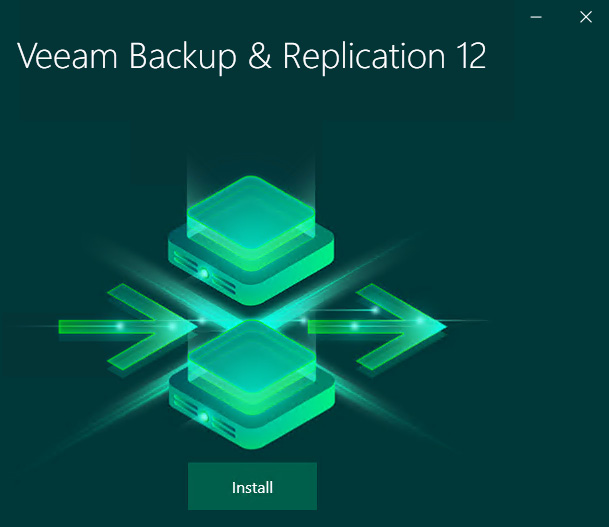
Figure 1.1 – Main installation screen
- Click on Install Veeam Backup & Replication:
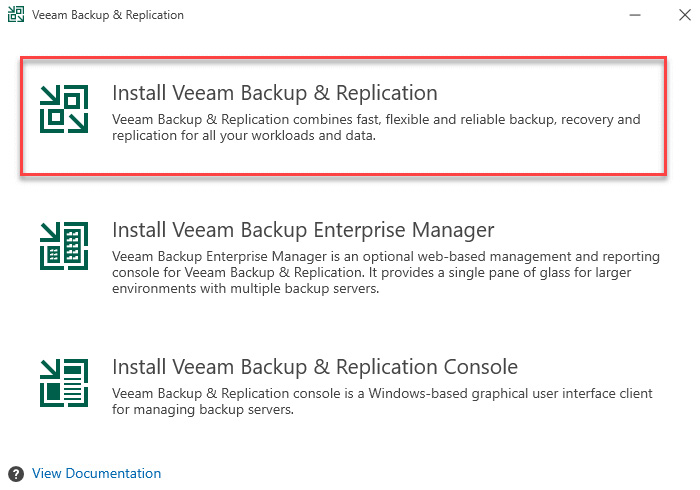
Figure 1.2 – Veeam Backup & Replication install option
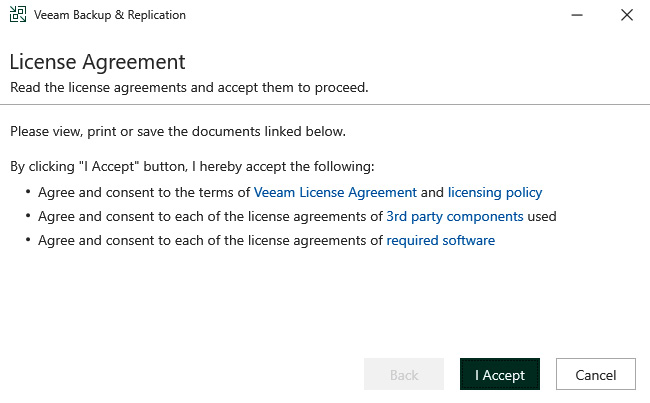
Figure 1.3 – License Agreement
- You will now need to provide a valid license file, whether you’ve purchased it or it’s a trial; if you do not have this at this stage of the installation, you can click Next to continue, and Veeam will operate in the Community (Free) Edition. When you obtain the license file, you can install that within the application under the menu and License:
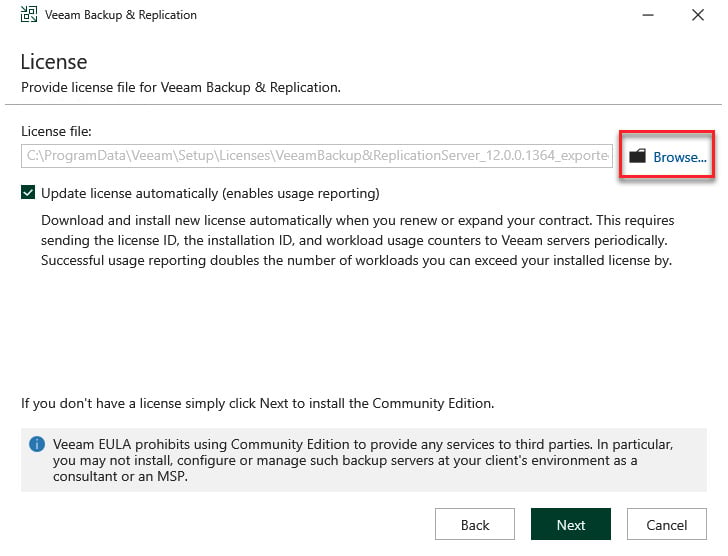
Figure 1.4 – License dialog window
- After clicking Next, the installer will do a system check for any required prerequisites. Should something be missing, you will be prompted and have the option to install the missing components:
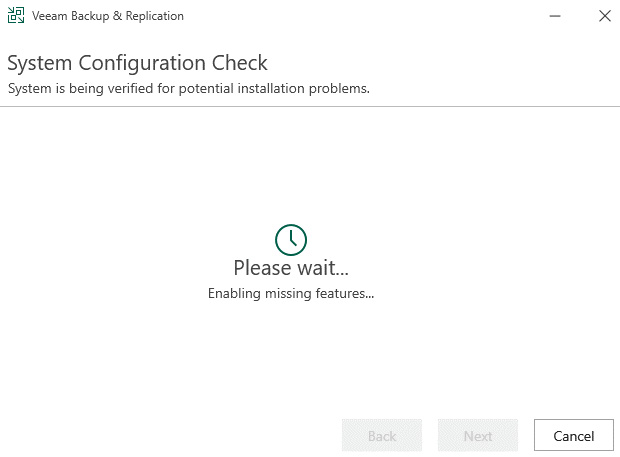
Figure 1.5 – System Configuration Check – missing components
- Once all the components get installed, you will be taken to the following screen. Unlike in previous Veeam Backup & Replication versions, this screen does not allow you to input a user account to run the services. Instead, with v12 of Veeam, you need to select the Customize Settings link:
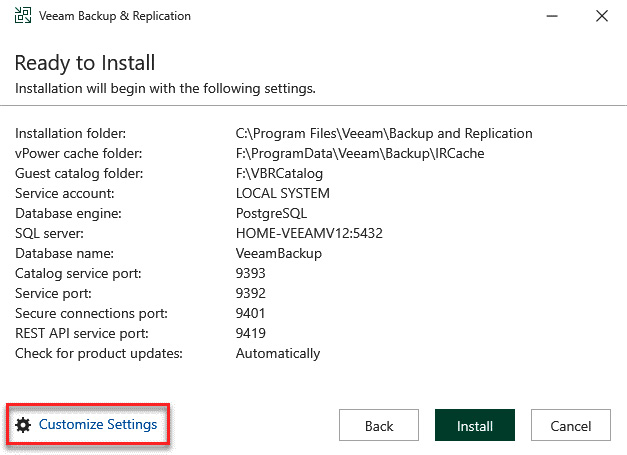
Figure 1.6 – Option to specify different settings
Note
Under the default configuration, you will see a new option for using PostgreSQL Server, which we will look at once the installation is completed.
- You will now be able to enter a user account for the Veeam services, better known as a Service Account. There are some recommended settings for this service account:
- You must have Local Administrator rights on the Veeam server.
- If you are using a separate SQL Server and not the Express edition (Microsoft SQL Server 2016 SP2 Express edition) included as part of the Veeam installation, you will require permission to create the database. The same goes for the PostgreSQL option.
- You will need full NTFS permissions to the folder containing the catalog.
For more details about these permissions, please visit https://helpcenter.veeam.com/docs/backup/vsphere/required_permissions.html?ver=120:
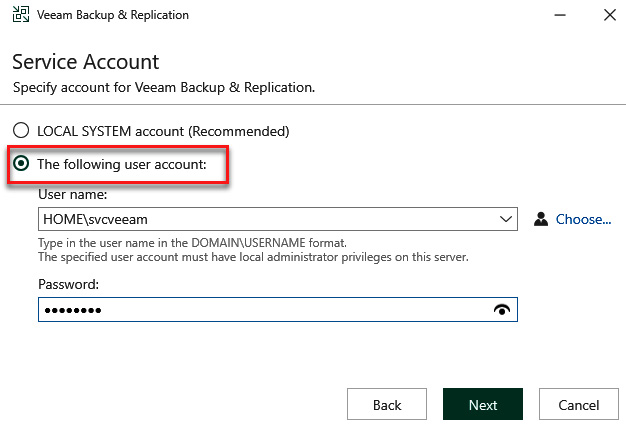
Figure 1.7 – Server user account
I am using an account I created on my lab server for this setup. In contrast, in a production scenario, you would already have a service account set up in Active Directory to enter at this stage.
- You will now select your database options, including the required Windows or SQL credentials. Click Next to continue:
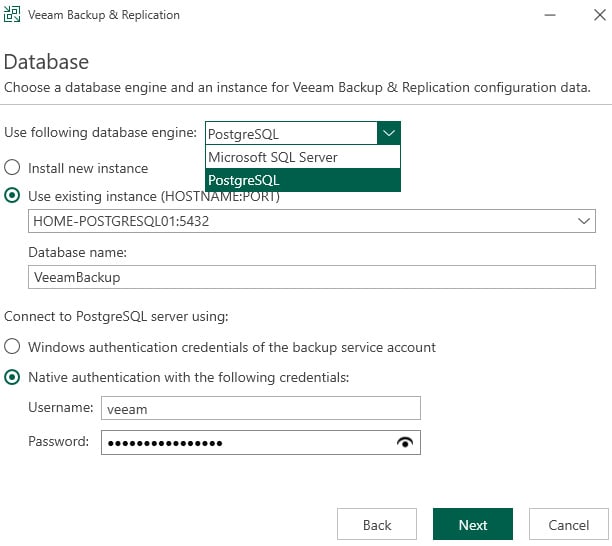
Figure 1.8 – Database server selection and credentials used
- The following screen allows you to change the installation locations for the installation components. Click Next once you have completed this part of the installation:
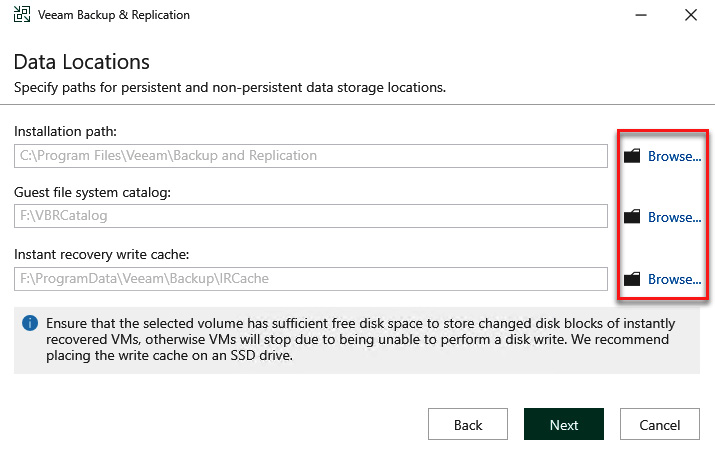
Figure 1.9 – Installation paths for the application
- You will then be prompted for the Port Configuration properties to be used. You can leave them as their defaults. Then, click Next:
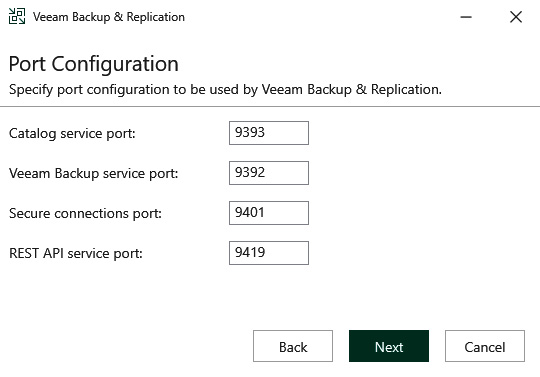
Figure 1.10 – Port Configuration selection
With the release of Veeam Backup & Replication v12, you can now use a different database type – PostgreSQL. This choice allows users to transition from Microsoft SQL, which requires licensing (SQL Express does not but has a 10 GB limit for the database size), but PostgreSQL does not because it is open source. The PostgreSQL database can be installed directly on the Veeam Backup Server or any other database server, such as Windows or Linux. For more details on PostgreSQL, please see the Further reading section at the end of this chapter.
You can now complete the installer by installing the local PostgreSQL Server instance and then the application. Veeam will also set the user account you selected to start all the services:
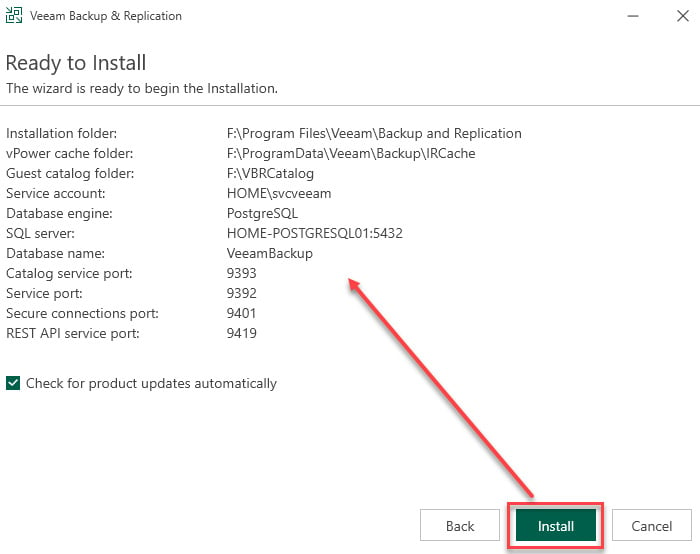
Figure 1.11 – Ready to Install – checking for updates
- Click Install to proceed with the installation and start setting up the components that work together with the backup server.
Note
PostgreSQL Server 14.5 will be installed during the installation, but at the time of writing, the latest release is 15.1.
- You will see the installation progress dialog after clicking Install:
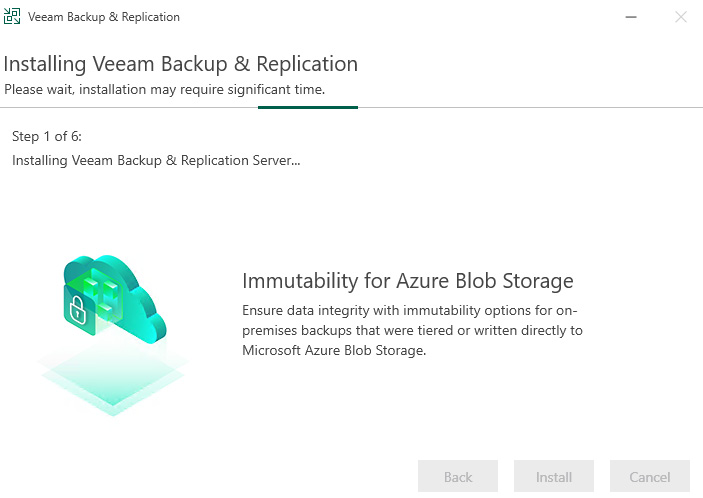
Figure 1.12 – Installation progress
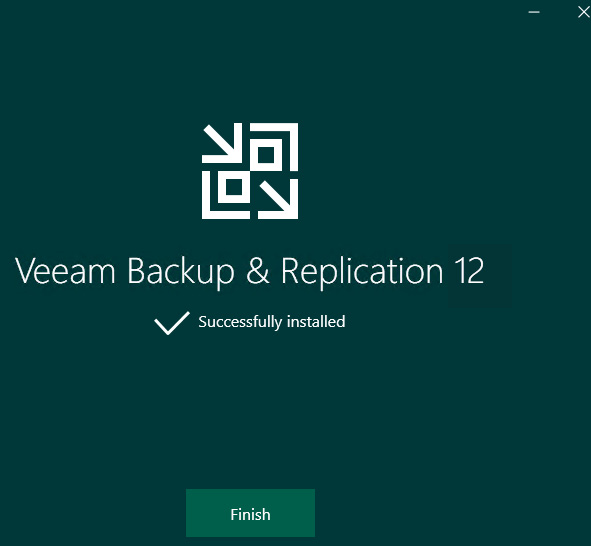
Figure 1.13 – Installation complete
Now, let’s start configuring the required settings for Veeam to work with VMware:
- Repository Server: The server that gets used for storing the backup files.
- Proxy Servers: The servers that perform all the backup tasks.
- VMware vCenter Credentials: This is used to connect and see your clusters, hosts, vApps, and virtual machines. vCenter server is not required as standalone ESXi hosts are also supported if licensed in VMware.
- When you first launch the Veeam Backup & Replication console, you will be taken directly to the Inventory tab, and Virtual Infrastructure will be in focus:
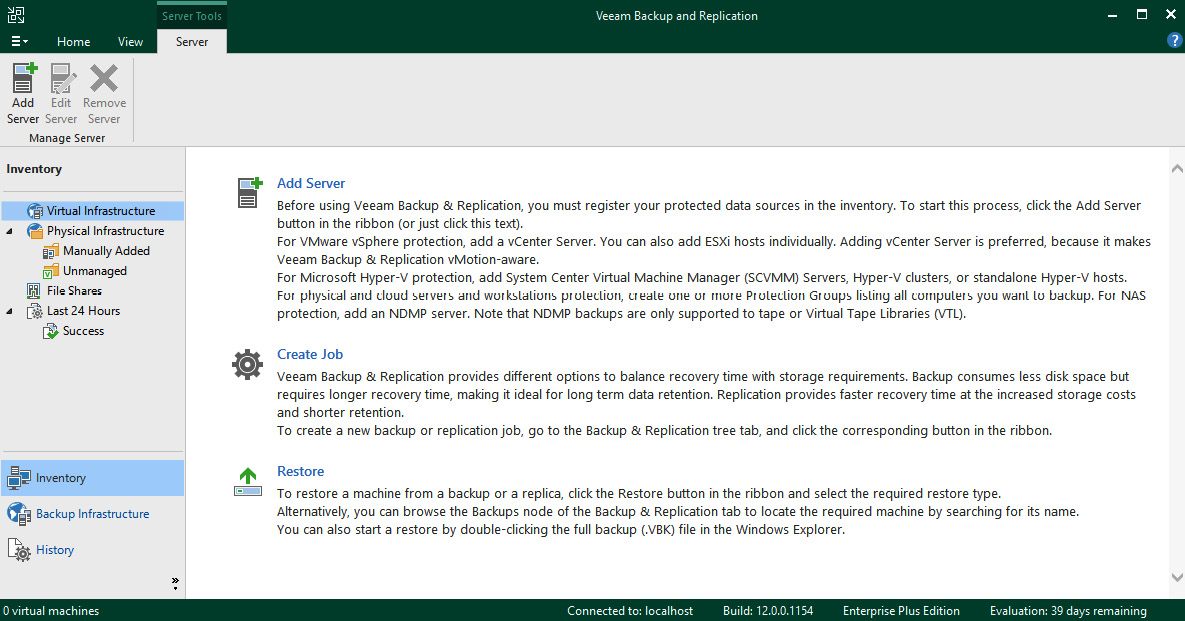
Figure 1.14 – Initial console screen
- This screen is where we will begin adding the Virtual Center so that you can start backing up your virtual machines. Click on the ADD SERVER option to begin this process. You will then be prompted to select what kind of server you wish to add. Choose VMware vSphere and then either vSphere or vCloud Director:
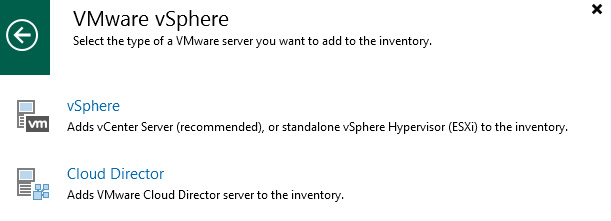
Figure 1.15 – vSphere or vCloud Director selection
You would typically select vSphere here; however, if you have vCloud Director in your environment, you may also want to choose this option. When you choose vSphere, you will be prompted for two things to complete the connection:
- The DNS or IP address of your vCenter server (DNS is the preferred method).
- Credentials: This can either be a
vsphere.localuser or a domain account that got set up for access. You are also able, at this point in the wizard, to add credentials to the Veeam console using the Add button.
- Enter the required credentials, click Next, and then click Apply to complete the VMware vSphere setup. You will now see your vCenter server listed under the Virtual Infrastructure section of the console and can browse the hosts and virtual machines.
Now, let’s look at the next piece required for the infrastructure: the Proxy server. By default, the Veeam Backup & Replication server is your VMware Backup Proxy and File Backup Proxy. Due to my lab’s limitations, I will use this server as an example, but in the real world, you would add multiple Proxy servers to your environment for better performance and as per best practices. Also, based on best practices, you would typically disable the Veeam Backup & Replication server as the Proxy Server to allow the other Proxy Servers to handle the workload.
The next component you will require is a Repository Server, which is the location where Veeam Backup & Replication will store your backup files. By default, Veeam Backup & Replication creates a Default Backup Repository, typically on the biggest drive attached to your backup server. This location will be where the Configuration Backups usually get backed up to. There are multiple options for adding a repository:
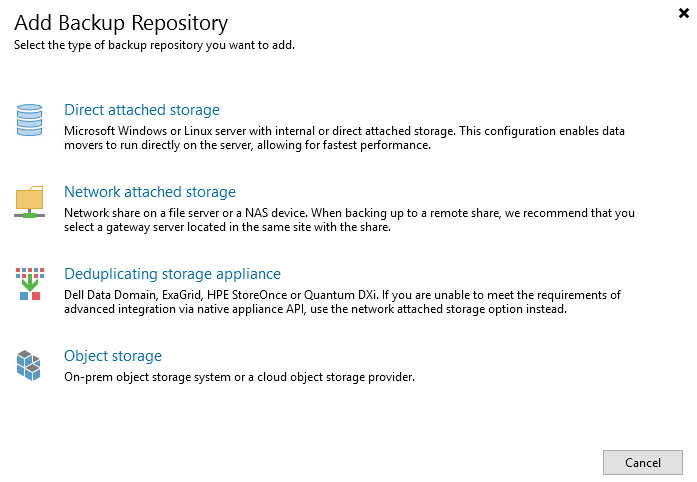
Figure 1.16 – Add Backup Repository selection
The first three selections are for block storage. At the same time, the last one is Object storage, which can now be used for backups directly due to the enhancement in v12 and can be part of a Scale-Out Backup Repository as any of the tiers – Performance, Capacity, and Archive for offloading data.
Note
Offloading data happens with the Capacity and Archive tiers.
Direct to Object is a new feature that was introduced with Veeam Backup & Replication v12. It allows users to move away from block storage and send their data directly to object storage, whether on-premises or in the cloud, with one of the many vendors such as Azure, AWS, Wasabi, and so on. The feature also allows you to use Object in the Performance Tier of a SOBR, of which you can use multiple object storage extents, but they have to be from the same vendor. You cannot mix them with Azure and AWS as both would need to be either one to be an acceptable configuration.
The following is a backup job configured to go to a SOBR with object storage as the Performance tier:
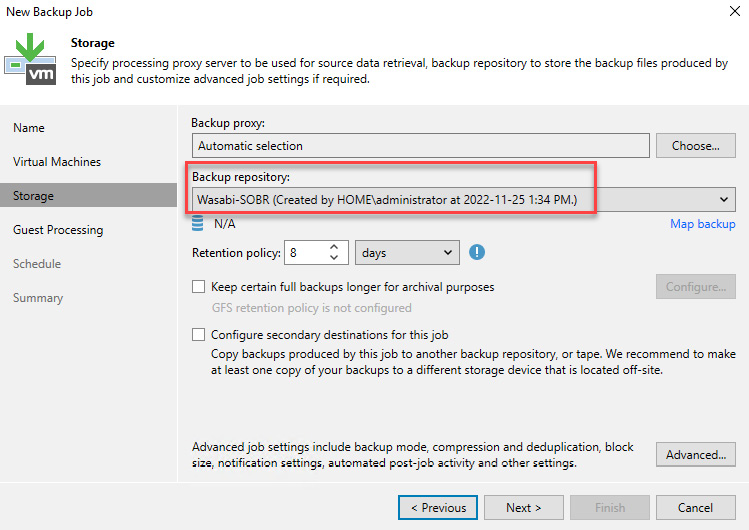
Figure 1.17 – Backup job using SOBR with Direct to Object storage
The following screenshot shows SOBR configured with Wasabi object storage under Performance Tier:
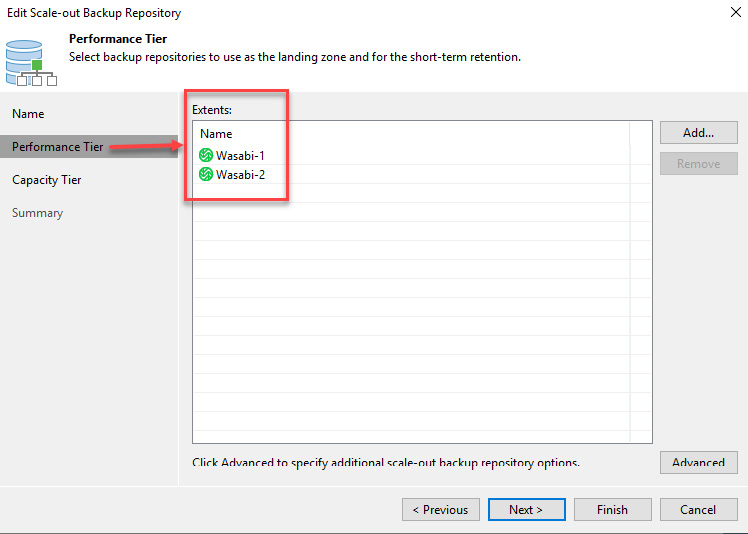
Figure 1.18 – SOBR using Wasabi Object Storage for Performance Tier
You have now installed and completed the basic configuration required for Veeam Backup & Replication. We will now look at how to optimize Proxy Servers and Repository Servers.
Configuring and optimizing Proxy Servers
Proxy Servers are the workhorses of the Veeam Backup & Replication v12 application, and they do all the heavy lifting or processing of tasks for backup and restore jobs. When you set up Veeam, you need to ensure that the Proxy Servers are configured as per best practices:
- https://bp.veeam.com/vbr/VBP/2_Design_Structures/D_Veeam_Components/D_backup_proxies/vmware_proxies.html
- https://helpcenter.veeam.com/docs/backup/vsphere/backup_proxy.html?ver=120
Introduced in Veeam Backup & Replication v12 is the ability to use Linux proxies in conjunction with Continuous Data Protection (CDP) and a standard proxy like in the previous version, v11a. This is another way for companies to move away from having to license a Windows Server and use one of the many Linux distributions. Not all Linux versions are supported, as noted here: https://helpcenter.veeam.com/archive/backup/120/vsphere/system_requirements.html#vmware-backup-proxy-server.
When you decide to deploy a Proxy server, Veeam Backup & Replication will install two components on the server:
- Veeam Installer Service: This gets used to check the server and upgrade software as required
- Veeam Data Mover: This is the processing engine for the Proxy server and does all the required tasks
Veeam Backup & Replication Proxy Servers use a transport mode to retrieve data during backup. Three standard modes are available, and they are listed in order, starting with the most efficient method:
- Direct Storage Access: The proxy is placed in the same network as your storage arrays and can retrieve data directly.
- Virtual Appliance: This mode mounts the VMDK files to the Proxy server for what we typically call Hot-Add Mode to back up the server data.
- Network: This mode is the least efficient but will be used when the previous methods are unavailable. It moves the data through your network stack. It is recommended not to use 1 GB but instead 10 GB.
In addition to these standard transport modes, which are provided natively for VMware environments, Veeam provides two other transport modes: Backup from Storage Snapshots and Direct NFS. These provide storage-specific transport options for NFS systems and storage systems that integrate with Veeam.
Refer to the integration with storage systems guide for more details: https://helpcenter.veeam.com/docs/backup/vsphere/storage_integration.html?ver=120.
Along with the transport modes, there are specific tasks that the Proxy server performs:
- Retrieving the VM data from storage
- Compressing data that’s being backed up
- Deduplicating data blocks so that only one copy is stored
- Encrypting data in transit and backup files
- Sending the data to the backup Repository Server (backup job) or another backup proxy server (replication job)
Veeam Proxy Servers leverage what is known as VMware vStorage APIs – Data Protection (formerly known as VMware vStorage APIs for Data Protection or VADP) when using all transport modes other than Backup from Storage Snapshots and Direct NFS.
It would be best if you considered the following regarding your Proxy Servers:
- Operating system: Most software vendors will always recommend the latest and greatest, so if you choose Windows, choose 2022. Alternatively, you can select Linux using the newest release (for example, Ubuntu 22.04.1 LTS). For Linux VMware, backup proxies support all transport modes as of Veeam Backup & Replication v11a and support being a CDP Proxy in v12.
- Proxy placement: Depending on the transport mode for the server, you will need to place it as close to the servers you want to back up, such as on a specific host in VMware. The closer to the source data, the better!
- Proxy sizing: This can be tricky to determine and will depend on the physical or virtual server. Veeam Proxy Servers complete tasks where one virtual disk is processed for a VM or one physical disk is processed for a server. Therefore, Veeam recommends one physical core or one vCPU and 2 GB of RAM per task.
Veeam has a formula for calculating the required resources for a Proxy server:
- D: Source data in MB
- W: Backup window in seconds
- T: Throughput in MB/s = D/W
- CR: Change rate
- CF: Cores required for a full backup = T/100
- CI: Cores required for an incremental backup = (T * CR)/25
Based on these requirements, we can use a data sample to perform the calculations:
- 500 virtual machines
- 100 TB of data
- An 8-hour backup window
- 10% change rate
Using these numbers, we can perform the following calculations:
We can use the numbers we calculated to determine the required amount of cores needed to run both full and incremental backups to meet our defined SLA.
Based on our calculations and considering that you require 2 GB of RAM for each task, you need a virtual server with 36 vCPUs and 72 GB of RAM. This size may seem like a considerable server, but keep in mind that it uses sample data. Your calculations will likely be much smaller or more extensive, depending on your dataset.
Should you use a physical server as a Proxy, you should have a server with two to 10 core CPUs. In the case of our sample data, two physical servers are what you require. If you are using virtual servers for proxies, the best practice is to configure them with a maximum of 8 vCPUs and add as many as needed for your environment – in this case, you would need five servers.
Should you want to size things based on incremental backups only, your requirements are less than half the full backup sizing – 15 vCPUs and 30 GB of RAM.
There are limitations for Proxy Servers that you need to be aware of when it comes to job processing and performance. As we noted previously, a Proxy server performs tasks, which are assigned CPU resources. Concurrent task processing depends on the resources available in your infrastructure and the number of Proxy Servers you have deployed. As shown in the following screenshot, when it comes to adding a Proxy server to Veeam Backup & Replication, there is the Max concurrent tasks option, which correlates to the number of CPUs that are assigned:
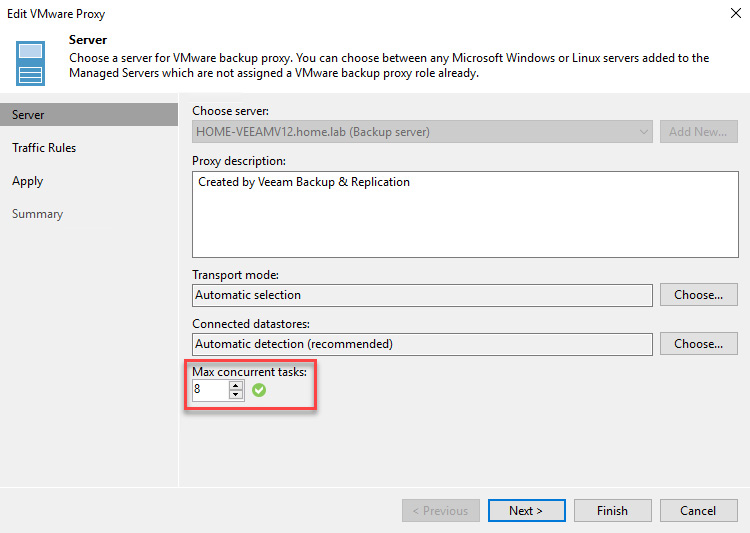
Figure 1.19 – Max concurrent tasks limitation for Proxy Servers
Task limits can be found at https://helpcenter.veeam.com/docs/backup/vsphere/limiting_tasks.html?ver=120.
Important note
Job performance will be impacted based on the tasks of a Proxy server. For example, if you had a Proxy server with 8 CPUs and added two virtual machines for backup, one with four disks and another with six disks, the Proxy server would process only eight of the 10 disks in parallel. The remaining two disks would have to wait on resources before being backed up in previous versions of Veeam.
With Veeam Backup & Replication v12, when you add a new Proxy server, it will have the concurrent tasks set automatically based on the number of CPUs/vCPUs that the physical or virtual server has. So, in the case of my lab, the Veeam server has four vCPU, so it got configured with eight concurrent tasks. Yes, this does not follow the sizing rule, but Veeam allows two times the number of CPUs/vCPUs for the concurrent task count.
You should now be able to right-size your Proxy Servers in terms of the CPU and RAM and understand proxy placement and how it processes tasks. Proxy Servers process and send data to Repository Servers, which is the focus of the next section.
How to set up Repository Servers for success
A Repository Server is a storage location for your backups, so setting them up right the first time will ensure you have the best performance. When creating a repository, it is always a good idea to follow the Veeam Backup & Replication best practices: https://bp.veeam.com/vbr/VBP/2_Design_Structures/D_Veeam_Components/D_backup_repositories/.
The following are some things to consider when setting up a repository:
- ReFS/XFS: With Windows 2019/2022, ensure you format your repository drive(s) as ReFS with 64k block sizing to take advantage of space savings for Synthetic Fulls and GFS. For Linux, you need to set up XFS and Reflink to take advantage of space-saving and Fast Cloning. In both of these situations, storage efficiency will be realized for Synthetic Full backups. This efficiency prevents duplication but is not deduplication.
- Sizing: Ensure that you adhere to the Veeam Backup & Replication recommendation of one core and 4 GB of RAM per repository task. Just like Proxy Servers, your Repository servers have task limits as well. At a minimum, you need two cores and 8 GB of RAM.
When calculating the sizing requirements, you need to consider your Proxy Servers and the amount of CPU configured; you then need to use a 3:1 ratio for the core count on a Repository Server.
Example: Your Proxy Server is configured with 8 CPUs; you need to configure the Repository Server with 2 CPUs based on this rule of 3:1. To configure the RAM, you must multiply the CPU count by four to end up with 8 GB of RAM.
When you use the Windows ReFS filesystem as your repository, you must consider the overhead required for the filesystem and add another 0.5 GB of RAM per terabyte of ReFS.
Setting up your task limits for a Repository Server differs from a Proxy server due to how tasks get consumed. The setting you choose will be handled differently:
- Per-VM Backup Files: When selected in Veeam Backup & Replication v12, this creates a backup chain per VM located in a job; rather than having a chain for all VMs together, they get separated, so each VM has its chain with a VBM, a VBK, and VIB files. Therefore, if the backup job has 10 virtual machines, it will consume 10 repository tasks and 10 proxy tasks.
For comparison, here’s an example of a v11a backup chain with one VBM (metadata file), the initial VBK (full backup file), and the VIB file (incremental backup file):

Figure 1.20 – Per VM backup chain in v11
Now, here’s an example of the new Per VM backup chain from v12 where each VM will have separate VBM, VBK, and VIB files:

Figure 1.21 – Per VM backup chain in v12
- No Per-VM Selection: The backup job consumes one repository task, and the proxy task will remain the same with one task per virtual disk.
Note
To find out more about task limits, go to https://helpcenter.veeam.com/docs/backup/vsphere/limiting_tasks.html?ver=120.
When you’re setting up a repository for the first time, you can set the task limit:
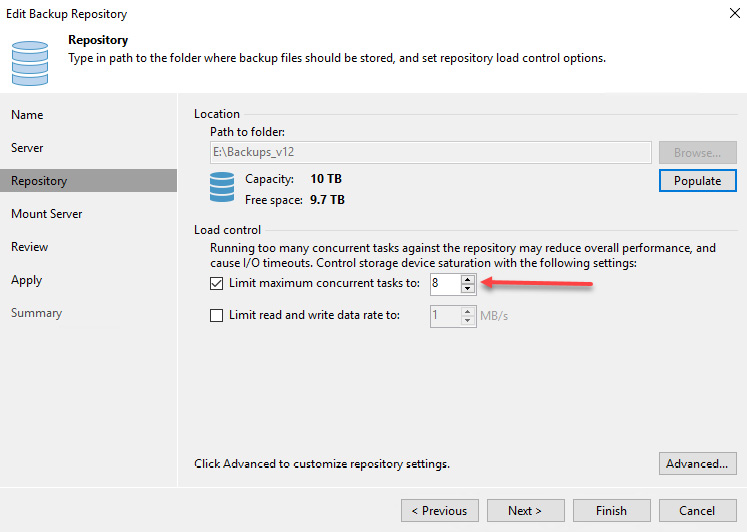
Figure 1.22 – Repository task limit
Important note
When you limit the number of tasks per repository and have jobs with many virtual machines requiring backups, this will be one of the bottlenecks in your environment. You also need to ensure that you do not set the limit too high, as that could overwhelm your storage, causing performance degradation. Make sure you test all your components and the resources available for your backup infrastructure.
After completing this section, you should be able to choose which type of filesystem you wish to use for your repository and size it correctly based on your CPU and RAM. We also discussed the per-VM versus no per-VM methods, including the new v12 per-VM chains and how they get created. We will use this knowledge to tie this into creating a Scale-Out Backup Repository.
Understanding the Scale-Out Backup Repository
So, what is a SOBR you ask? A SOBR uses multiple backup repositories, called performance extents, to create a sizeable horizontal scaling repository system. Veeam Backup & Replication can use multiple repositories of various types, such as the following:
- Windows Backup Repositories: NTFS or the recommended ReFS.
- Linux Backup Repositories: XFS with Reflink.
- Object Storage: Direct to object storage. This is now available in v12 for us to use for all tiers of a SOBR, including the Performance Tier.
- Shared Folder: NFS, SMB, or CIFS.
- Deduplication storage appliances.
SOBR can expand with on-premises storage such as block storage, object storage, or a cloud-based object repository known as a Capacity Extent. Veeam Backup & Replication combines the Performance extents, Capacity extents, and Archive extents into one to summarize their capacities:
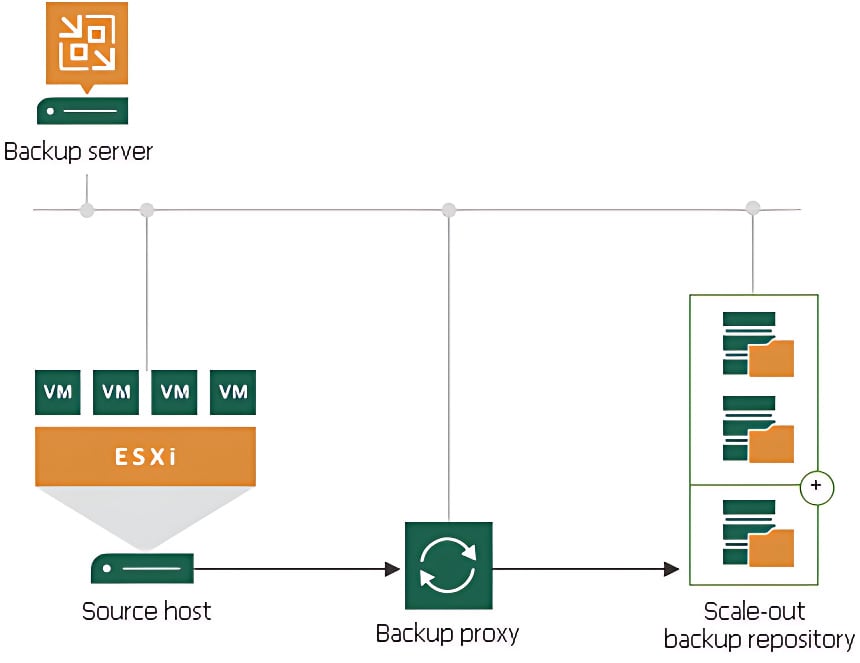
Figure 1.23 – Scale-Out Backup Repository
The ability to use a SOBR is dependent on the license version that you use with Veeam Backup & Replication:
- Enterprise: Allows for a total of two SOBRs with three active extents and unlimited inactive extents
- Enterprise Plus & VUL (Veeam Universal License): Provides an unlimited number of SOBRs with as many performance extents needed but only one Capacity/Archive Tier per SOBR
Tip
Should you downgrade your licensing from Enterprise Plus or Enterprise to Standard, you will lose the ability to target your jobs to the SOBR. You can, however, restore data from the SOBR.
The different license types limit you in the number of SOBRs and extents per SOBR you can configure. As we noted previously, there is a limit of two for Enterprise and an unlimited number for Enterprise Plus/VUL.
Tip
For the best performance and manageability, it is best to keep your SOBR limited to three to four extents if possible. If you are using object storage, then one of the components of the SOBR will be the Capacity Tier.
The SOBR works with many types of jobs or tasks in Veeam Backup & Replication:
- Backup jobs
- Backup copy jobs
- VeeamZIP jobs
- Agent backups – Linux or Windows agent v2.0 or later
- NAS Backup jobs
- Nutanix AHV backup jobs
- Veeam Agent for Mac
- Veeam backups for Amazon and Microsoft Azure (via backup copy jobs)
The next thing to keep in mind is the limitations of using a SOBR, as there are certain things you cannot do:
- Only Enterprise, Enterprise Plus, and VUL licenses can be used
- You cannot use it as a target for configuration backup jobs, replication jobs, VM copy jobs, Veeam Agent v1.5 or earlier for Windows, or v1.0 Update1 or earlier for Linux
- Adding a repository as an extent to a SOBR will not be allowed if there is an unsupported job using the repository
- Rotating drives are not supported
- You are unable to use the same extent in two SOBRs
Please refer to the following limitations page on the Veeam Backup & Replication website for more details: https://helpcenter.veeam.com/docs/backup/vsphere/limitations-for-sobr.html?ver=120.
When it comes to the makeup of the SOBR, there are three tiers:
- Performance Tier: Fast storage and fastest access to data can now include object storage, whether on-premises or cloud-based, in v12
- Capacity Tier: Typically, this is object storage for archival and offloading capabilities
- Archive Tier: Additional object storage for long-term archival and infrequently accessed objects
Note
When adding object storage as the Performance Tier, you must ensure that each one added is of the same vendor. For example, if the first Performance Tier you add is from Wasabi, the subsequent extents must also be Wasabi-based as you cannot add something such as Amazon S3. This will be crucial in planning if you decide to start using object storage in a SOBR.
For the performance tier, you will want to ensure it has the fastest storage, block, or object storage so that when access to files and restores is required, it is as fast as possible. When you create a standard repository before adding it to a SOBR, specific settings are retained in the SOBR:
- The number of simultaneous tasks it can perform
- The storage read and write speeds
- The data decompression settings on the storage
- The block alignment settings of the storage
The SOBR will not inherit a repository backed by rotating drives. If you choose to use the Per-VM backup option, this is on by default in a SOBR.
Note
If you decide to use cloud-based object storage, keep in mind that it will not be the same as using block storage or on-premises object storage as it will need to pull data from the cloud back to on-premises, which could slow restoration down.
Something else to think about is the backup file placement policy that you will use. There are pros and cons to both, and specific operating systems, such as ReFS and XFS, require one over the other. The two types of placement policies are as follows:
- Data locality
- Performance
Please refer to the Performance Tier page on the Veeam Backup & Replication website for more information: https://helpcenter.veeam.com/docs/backup/vsphere/backup_repository_sobr_extents.html?ver=120.
Data locality allows the scale-out to place all backup files in the chain to the same extent within the SOBR, keeping files together. In contrast, the Performance policy will enable you to choose which extents to use for both full backup files (VBK) and incremental files (VIB).
For further information on backup placement, see this Veeam Backup & Replication page: https://helpcenter.veeam.com/docs/backup/vsphere/backup_repository_sobr_placement.html?ver=120.
Now, when it comes to the Capacity Tier, there can only be one per scale-out, and it is required to be one of the options shown in the following screenshot:
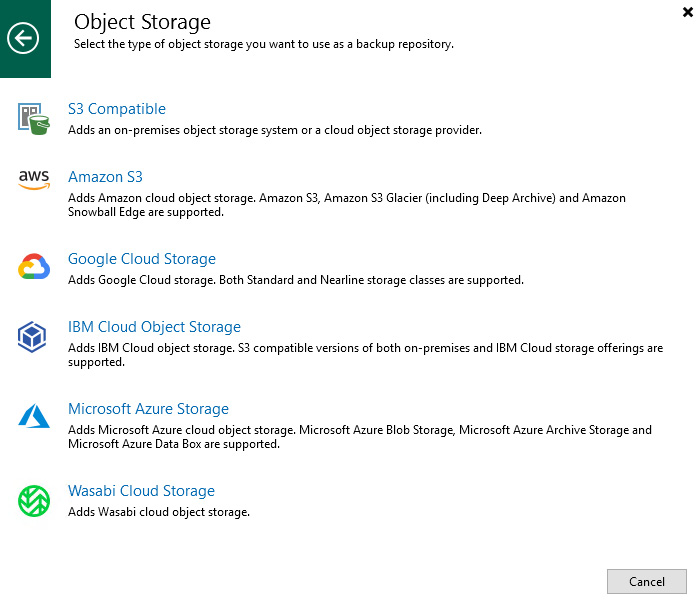
Figure 1.24 – Object Storage options for the Capacity Extent
Note
These same object storage options for the Capacity Tier apply to the Performance Tier now and, as noted, have to be the same for each extent you want to add to the Performance Tier.
Using a Capacity Tier as part of your SOBR is suitable for the following reasons:
- You can tier off older data when your SOBR reaches a specific percentage capacity to allow you to free up storage space.
- Company policy stipulates you keep a certain amount of data onsite. Then, all older data is tiered off to the Capacity Tier after X days.
- Using it falls into the 3-2-1-1-0 rule, where one copy of the information is offsite. See this blog post for more details on the 3-2-1-1-0 rule: https://www.veeam.com/blog/3-2-1-rule-for-ransomware-protection.html.
You specify the Capacity tier after creating it as a standard repository, during the SOBR wizard:
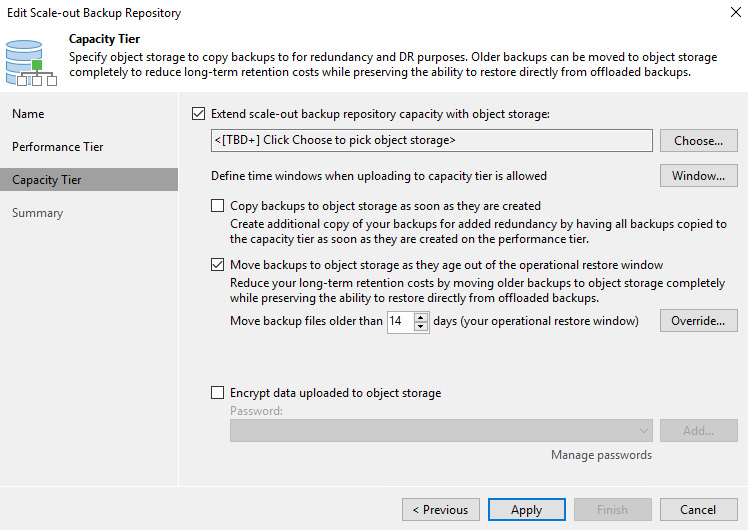
Figure 1.25 – Capacity Tier of the Edit Scale-out Backup Repository wizard
Please visit the Capacity Tier page on the Veeam Backup & Replication website for more information: https://helpcenter.veeam.com/docs/backup/vsphere/capacity_tier.html?ver=120.
We will now tie everything we’ve learned together and create a SOBR. First, you will need to open the Veeam Backup & Replication console and select the BACKUP INFRASTRUCTURE section at the bottom left. Then, click on the Scale-out Repositories option on the left:
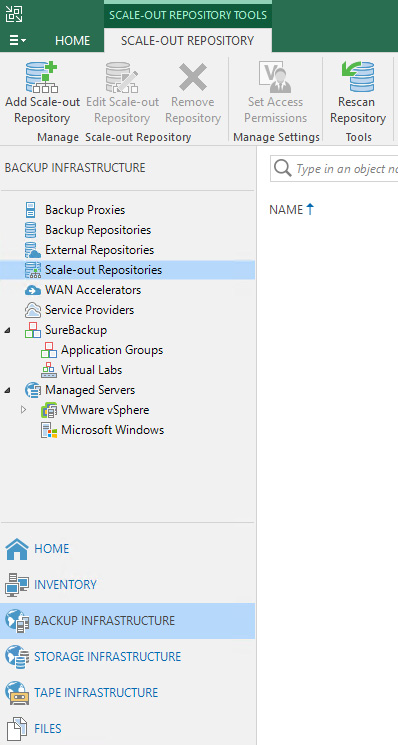
Figure 1.26 – The Scale-out Repositories section of the console
Once you’re in this section, you can either click the Add Scale-out Repository button in the toolbar or, on the right-hand pane, right-click and select Add Scale-out backup repository….
At this point, you must name the SOBR and give it a thoughtful description; the default name is Scale-out Backup Repository 1. Then, click Next to go to the Performance Tier section of the wizard:
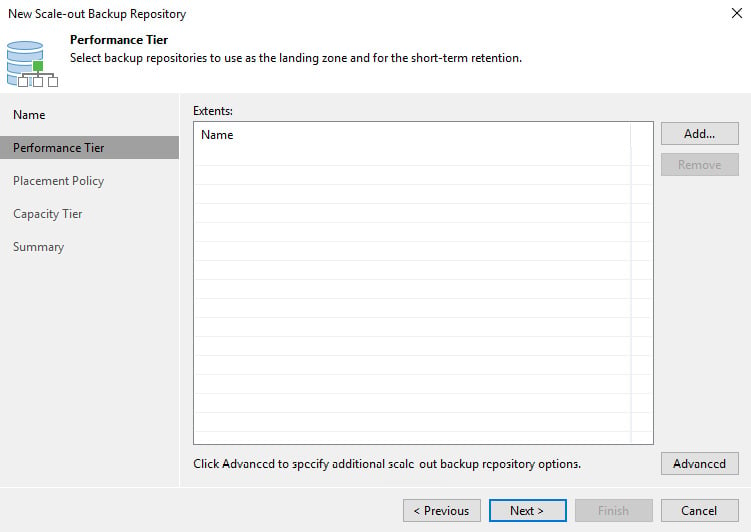
Figure 1.27 – The New Scale-out Backup Repository wizard – Performance Tier
In this section, click the Add… button and choose the standard repositories that will be part of your SOBR. You can also click on the Advanced button to choose two options:
- Use per-VM backup files (recommended)
- Perform a full backup when the required extent is offline
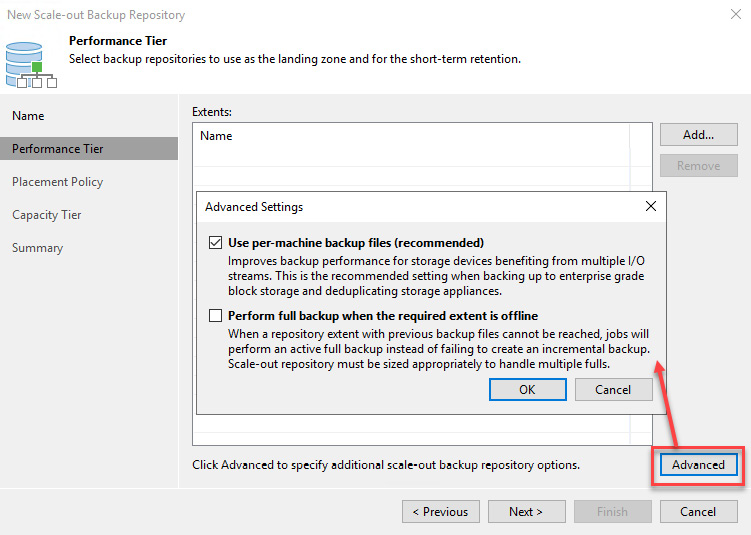
Figure 1.28 – Advanced settings for the Performance Tier area of SOBR
Click the Next button to proceed. At this point, you must pick your placement policy – Data Locality or Performance. As we mentioned, if you’re using ReFS or XFS, you must select Data Locality to take advantage of each operating system’s storage savings. Click Next after making your choice.
You can now choose to use Capacity Tier for your SOBR or click the Apply button to finish. Note that when you select a Capacity Tier, there are several options you can enable:
- Copy backups to object storage as soon as they get created in the Performance Tier.
- Move backups to object storage as they age out of the restore window. The default is 14 days. You can also click the Override button to specify offloading until the space required is below a certain percentage.
- You can also encrypt your data upload to the object storage as another level of security:
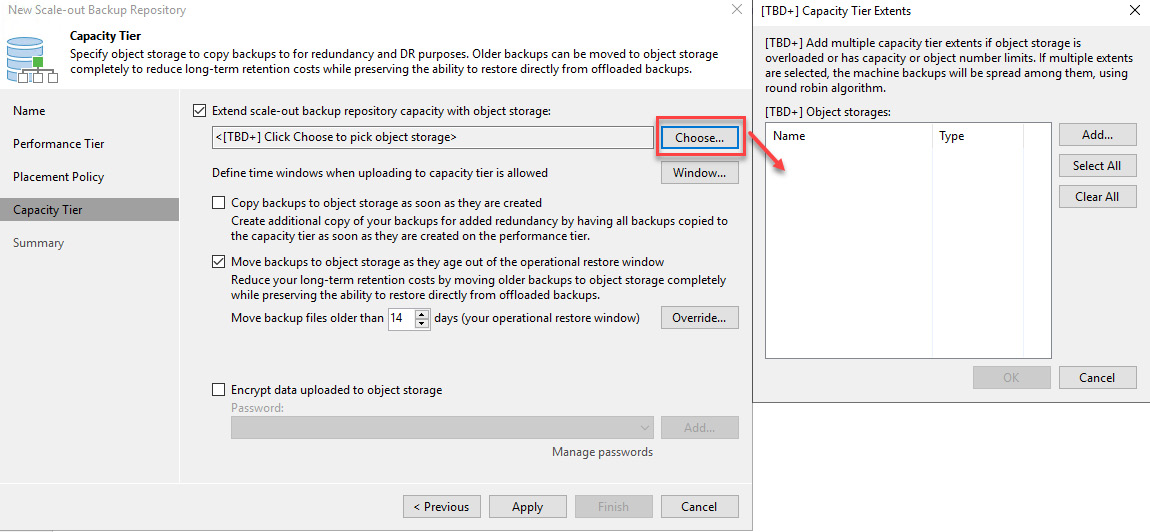
Figure 1.29 – Capacity Tier selection for Scale-out
Note that some Capacity Tier targets support immutability. This feature is an essential attribute in the war on ransomware. In v12, Capacity Tier targets that support immutability include AWS S3 with object lock and S3-compatible object storage systems.
Please see the Veeam Readiness program to determine whether your object storage is supported here: https://www.veeam.com/alliance-partner-technical-programs.html?programCategory=ready-object-immutable.
Once complete, you will see your new SOBR. When you select it, you will see the performance tier extents and the Capacity Tier if you chose it:

Figure 1.30 – SOBR created
For further information on the SOBR, visit this Veeam Backup & Replication page: https://helpcenter.veeam.com/docs/backup/vsphere/sobr_add.html?ver=120.
The final thing to discuss is how to manage the SOBR after creating it. Once created, you may need to do any of the following:
- Edit its settings to change the performance policy, for example.
- You may need to rescan the repository to update the configuration in the database.
- Extend the performance tier by adding another extent to the SOBR.
- Put an extent in maintenance mode to perform maintenance on the server that holds it or evacuate the backups to remove the extent.
- Switch an extent into Sealed Mode, where you do not want any more writes to it but can still restore from it. This process allows you to replace the extent with a new one.
- Run a report on the SOBR.
- Remove an extent from the SOBR, which requires maintenance mode, evacuate, and remove.
- Remove the SOBR altogether.
Two other new things with Veeam Backup & Replication v12 for managing SOBR and repositories, in general, are the VeeaMover and SOBR Rebalance options. Both of these features are new to v12 and will be covered in Chapter 3, Scale-Out Backup Repository – What’s New, but a brief overview follows.
VeeaMover
VeeaMover is a built-in utility that simplifies operations for moving data between repositories and VMs between jobs. It allows you to move from ReFS to ReFS while keeping the block clone savings (a similar thing happens with XFS too). You can also move from NTFS to ReFS to take advantage of the block clone savings in ReFS. Also, moving VMs from one job to another is realized with VeeaMover.
SOBR Rebalance
When you use a SOBR with multiple extents, depending on your placement policy, some of the extents fill up more than others. There is now a new feature called SOBR Rebalance, which helps with this by spreading backups across the extents. This operation does require an outage; however, moving the files around and depending on their size, this could take some time.
As noted, we will cover more of the VeeaMover and SOBR Rebalance in Chapter 3.
Once set up within Veeam Backup & Replication v12, the SOBR is pretty self-sufficient. Still, there are maintenance tasks that you need to do to ensure optimal performance and plenty of storage is available for backups.
For more information on SOBR management, please visit the following page on the Veeam Backup & Replication website: https://helpcenter.veeam.com/docs/backup/vsphere/managing_sobr_data.html?ver=120.
Upgrading Veeam Backup & Replication to v12
This section will discuss the process required to upgrade your existing Veeam Backup & Replication environment to v12. If you have Veeam Backup & Replication v10 installed, you can proceed with the following steps to conduct the upgrade.
Important note
If you have Veeam Enterprise Manager installed on your server, you will be prompted to upgrade this before upgrading Veeam Backup & Replication.
Once your server is ready and you have downloaded the ISO file and mounted it, follow these steps to upgrade your server and components:
- Run the
setup.exefile on the mounted ISO drive:
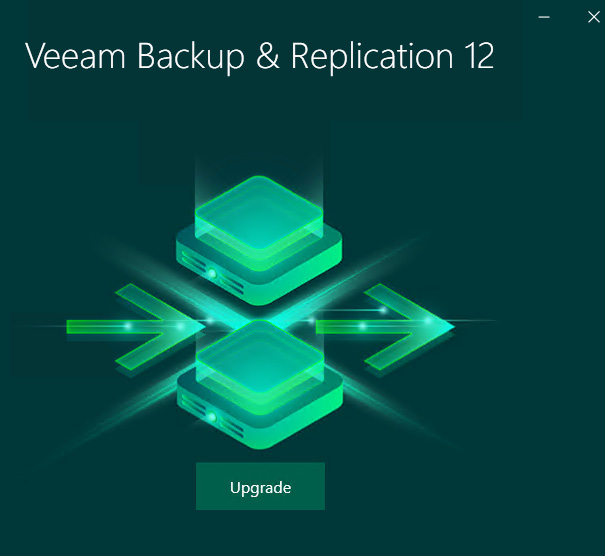
Figure 1.31 – Main installation screen – Upgrade
- Click on the Upgrade button to proceed.
- You will be prompted to click on the component to upgrade – in this case, Upgrade Veeam Backup & Replication:
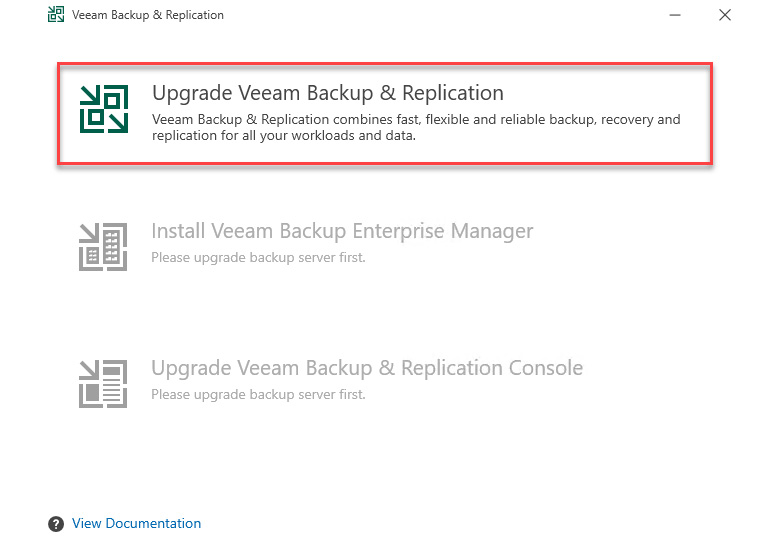
Figure 1.32 – Upgrade selection
Note
If Veeam Backup Enterprise Manager were on your server, you would be prompted to upgrade this before you could upgrade Veeam Backup & Replication.
- After clicking Veeam Backup & Replication, the upgrade installation will proceed.
- The License Agreement dialog is the next thing you will see. Here, click I Accept to proceed:
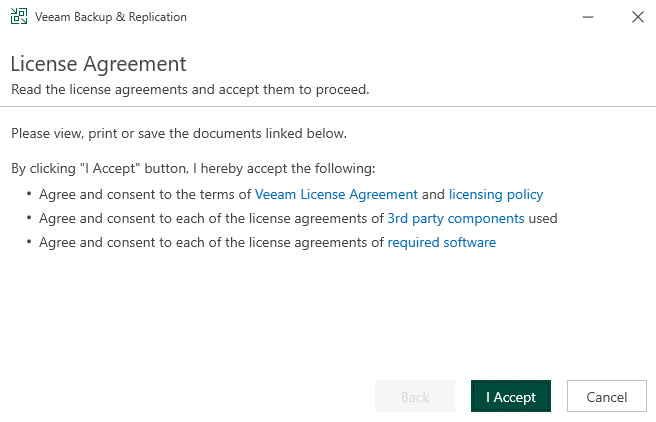
Figure 1.33 – License Agreement dialog
- After accepting the license agreement, you will be presented with the Upgrade dialog, which shows the components to be upgraded with the current and new versions. You can also check the Update remote components automatically option so that they are upgraded on console launch:
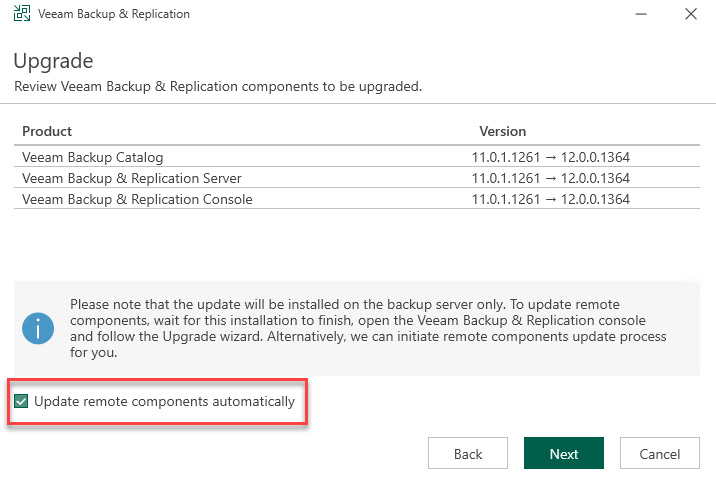
Figure 1.34 – Upgrade dialog with components
- After clicking Next, the next screen you’ll see is the License dialog. This is where you can use the Browse… button to enter your license and then click Next to proceed:
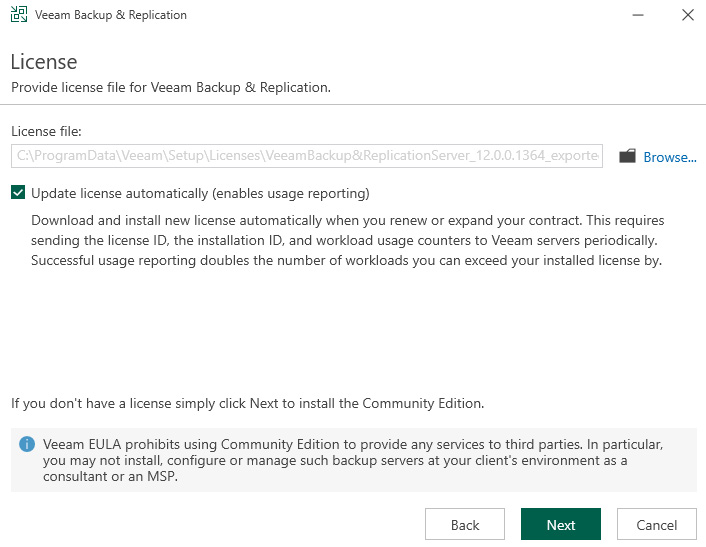
Figure 1.35 – License selection dialog
- The installer will now performs a system check and enable any missing features required for the installation to continue:
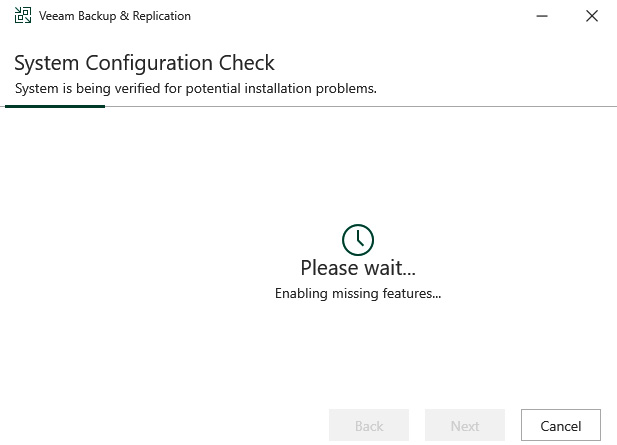
Figure 1.36 – System Configuration Check
- Now, you’ll be on the Service Account screen, which you will use for the Veeam Backup & Replication services to run under. In my case, I am using a LOCAL SYSTEM account, which is the Administrator. However, to follow best practices, you should create a service account ahead of time. Click Next to proceed after entering the required account information:
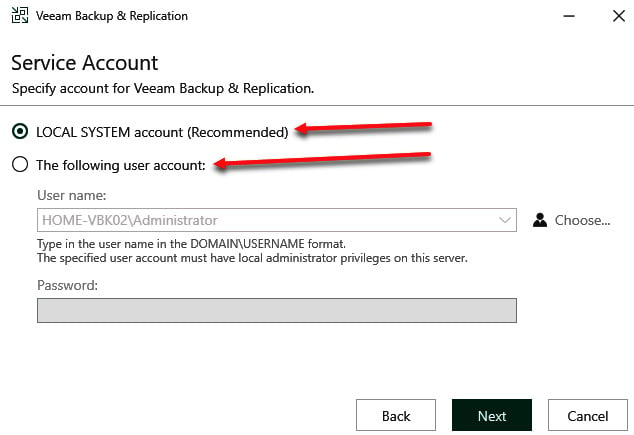
Figure 1.37 – Service Account selection
- The next screen is the Database dialog, which will detect your current installation and ask you to verify the connection settings. You should also follow best practices and have a login account created on your database server; in this case, SQL Server is using my Windows login credentials, a small deployment. Click Next after validating the settings:
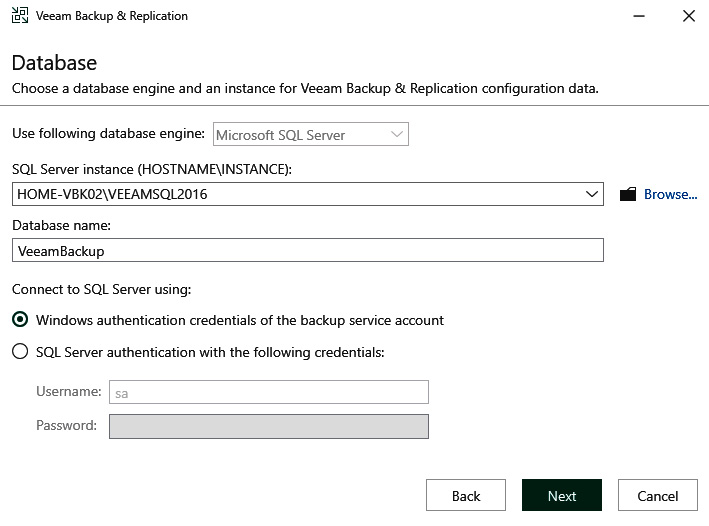
Figure 1.38 – Database validation
- You will be warned about the database being upgraded after clicking on Next. Be sure to click Yes to proceed:
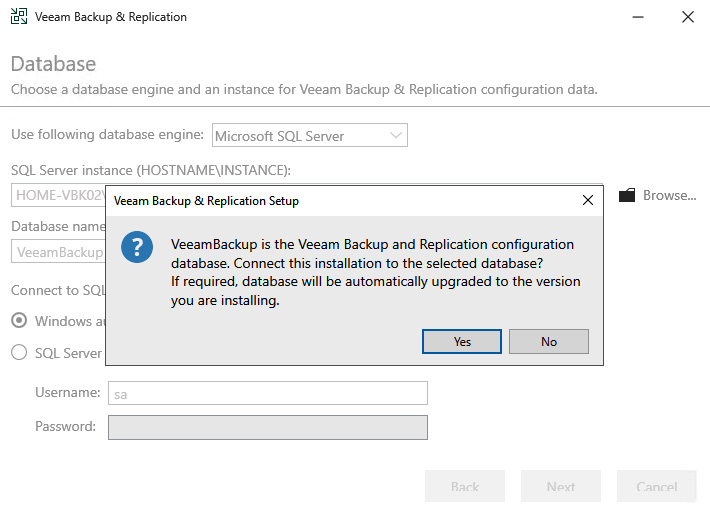
Figure 1.39 – Database upgrade warning
- At this point, a Configuration Check process will be performed to ensure there are no incompatibilities for the upgrade and highlights them if there are any so that they can be resolved before you proceed with the upgrade. Click Next to proceed:
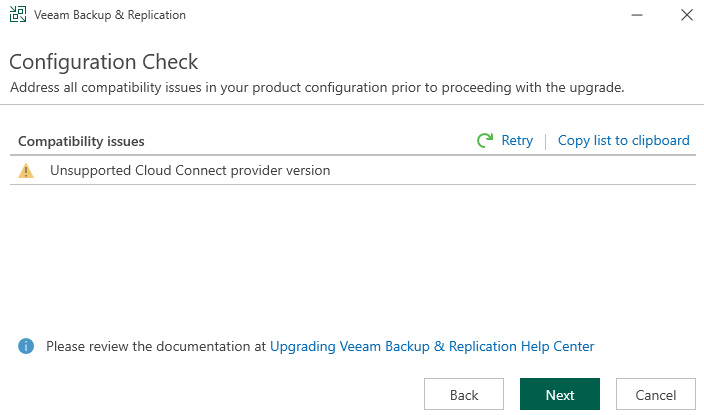
Figure 1.40 – Configuration Check for incompatibilities
Note
In my case, I have my Veeam Backup & Replication server pointed to a Service Provider record that is not compatible due to still being at v11. This check will allow users that have a Veeam Cloud connect to a Service Provider to see that they have not upgraded and be able to pause their upgrade until the Service Provider upgrades their side first. I proceeded with the upgrade for this book.
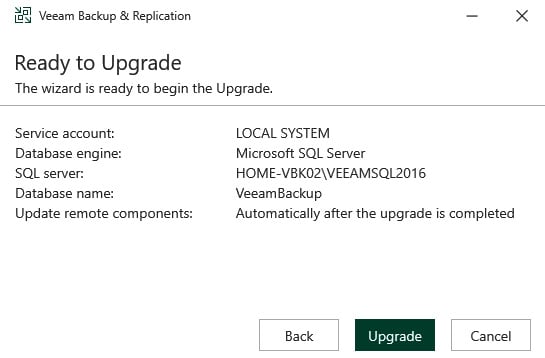
Figure 1.41 – Ready to Upgrade dialog
- The next dialog you’ll see is the progress dialog, which shows six steps that must be done to complete the upgrade:
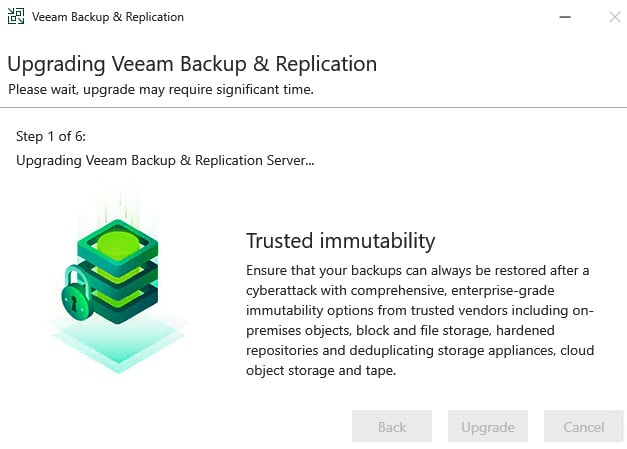
Figure 1.42 – Upgrade progress
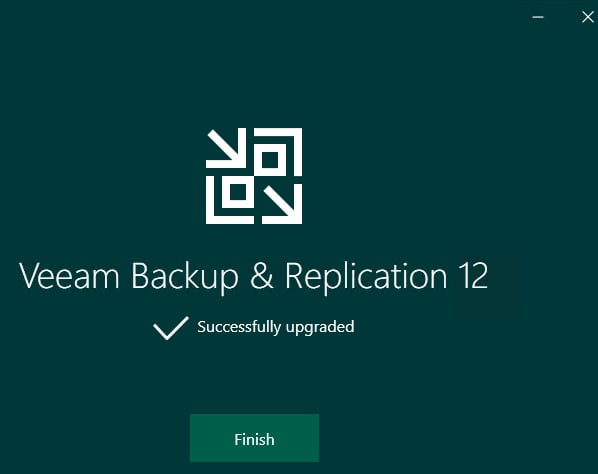
Figure 1.43 – Upgrade completed
The upgrade process is now complete, and your jobs should continue to run as scheduled. You will now have the option to upgrade your backup chains to the Per-VM Backup Chains, which are new within Veeam Backup & Replication v12.
You can do this upgrade in the console by going to the Home tab and selecting Backups. Right-click on the backup job and select Upgrade backup chain format:
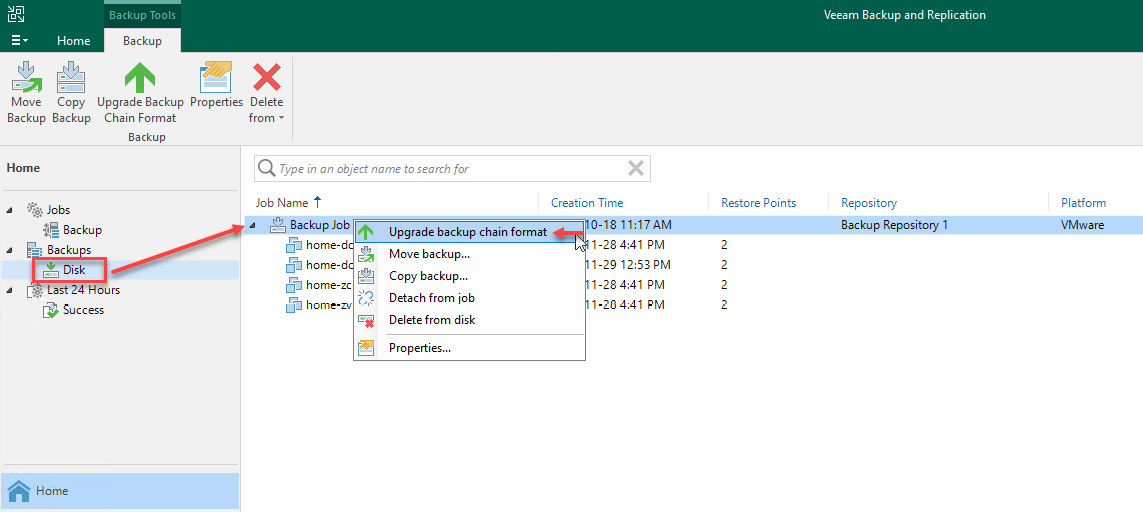
Figure 1.44 – Upgrade backup chain format
As shown in Figure 1.21, the layout of the new files for each server has VBM (metadata) and backup files (VBK/VIB).
After you select Upgrade backup chain format, you will be prompted with a dialog to proceed. Click OK. A status window will appear, showing the progress of the upgrade:

Figure 1.45 – Backup chain upgrade proceed dialog
After you click OK, you will see the progress dialog and the upgrade upon completion:
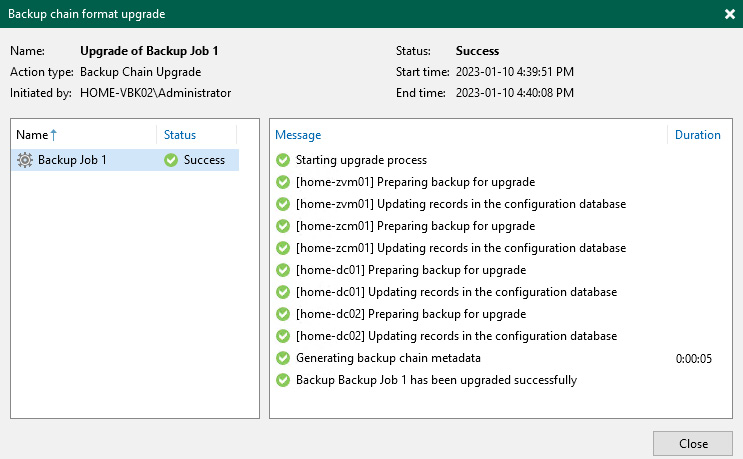
Figure 1.46 – Backup chain format upgrade progress
With that, we have covered installing and upgrading the backup chain format to the new Per-VM backup chains. I will now summarize the lessons learned in this chapter.
Summary
This chapter provided you with the tools required to install Veeam Backup & Replication v12 and the components that make up the installation. We discussed the prerequisites, including the versions of SQL Server or PostgreSQL that you can use – Express or SQL Standard/Enterprise and PostgreSQL locally installed with Veeam or a remote instance on Windows/Linux. Then, we addressed how to set up Proxy Servers, the configuration best practices, and optimal settings. This part was then followed by a discussion on repositories and how to create them and included best practices and optimizations for best performance. Afterward, we looked at Scale-Out Backup Repositories and how to set them up, including the Performance Tier and the Capacity Tier, and how to manage them once they’ve been set up. Lastly, we looked at the upgrade process for Veeam Backup & Replication to update an existing instance from version 11a to 12 and convert the backup chains into the new Per-VM backups.
This chapter should have helped ensure that you have all the basics covered. The next chapter will cover many core architecture changes within Veeam Backup & Replication v12.
Further reading
To learn more about the topics that were covered in this chapter, take a look at the following resources:
- Veeam Community Edition: https://www.veeam.com/virtual-machine-backup-solution-free.html
- PostgreSQL Server: https://www.postgresql.org/
- An Object Storage Repository in Veeam: https://helpcenter.veeam.com/docs/backup/vsphere/object_storage_repository.html?ver=120
- Backup Proxies: https://helpcenter.veeam.com/docs/backup/vsphere/backup_proxy_requirements.html?ver=120





















